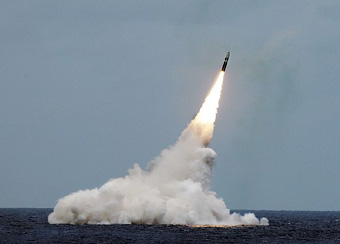
Trident II D5 missile launched from the USS Ohio near coast of Florida in August 2016/
Image courtesy of US Department of Defense
Did May Omit Florida Test Failure
of Trident?
| published January 23, 2017 |
By R. Alan Clanton, Thursday Review editor
When requesting military funding from parliament last July, British Prime Minister Teresa May failed to inform members that a test of an unarmed Trident missile—designed to carry a live nuclear payload—failed in June of 2016 when it was launched from a Royal Navy submarine off the coast of Florida.
British lawmakers want to know why May omitted any mention of the missile failure during debate about funding of British nuclear submarines only weeks after the test was conducted.
According to sources in Britain and within the U.S. military, a scheduled test launch in June produced near-disaster when the missile veered off course and began heading not toward sea—as was expected and planned—but west toward the Florida coastline and populated areas. The test was conducted in secret, with components of British and U.S. military personnel working alongside NASA engineers.
The June test was conducted aboard the HMS Vengeance, which had previously undergone a major refit and upgrade at the Devonport shipyards in Britain. After routine sea trials, the HMS Vengeance had docked at Port Canaveral, in Florida, where it awaited final approval for the live fire test.
According to a variety of sources, the test was expected to produce reliably solid results for both the submarine and the missile, but instead something went wrong. The Trident II D5 missile was detonated manually to avert disaster. Its intended target was a largely untraveled expanse of ocean a thousand miles off the west coast of Africa, an area known as the eastern firing range. Instead, an indeterminate malfunction sent the missile in the wrong direction, possibly toward the heavily populated coastline of Florida.
In July, May proposed to members of the House of Commons funding of roughly $50 billion (40 billion pounds) for the Trident program. Her request came only six weeks after she took office, when she stepped into the role as Prime Minister after the British vote to exit the European Union left the leadership of David Cameron shaken and politically damaged.
Similar tests of unarmed Trident II D5s were conducted aboard American submarines during the summer, including test launches from the USS Ohio along the Florida coastline (see photo).
In an interview with British media over the weekend, May would not provide a direct answer to whether the test had failed, nor did she offer an explanation for why she omitted the test failure to British lawmakers. But May described such tests as routine, telling reporters that tests are conducted “regularly,” even though in the case of the Trident, test firings—because of the high cost of each rocket—are actually very rare. Some military press and U.S. military analysts say that the Trident has been test-fired only about four-to-five times since the program’s initiation decades ago; each missile, even without its warhead, costs about $20 million.
Some in Britain want to know if May knowingly or deliberately mislead members of parliament—omitting any mention of the Florida failure for fear that opposition to the military spending might gain momentum. After a lengthy debate last summer, lawmakers agreed to a program of four submarines outfitted for ballistic missiles.
Though the majority of members of parliament supported the plan, dissent came from some on both the left and the right, with opponents describing the Trident as basically obsolete in an age more defined by terrorism and radical Islamic jihadists than by global strategic threats. Supporters say that the submarines and their missiles would be a critical part of the NATO arsenal, and a valuable tool for the defensive capability of the U.K.
But now some who supported the Trident program are concerned that they were misled, or kept in the dark, by not being informed of the June test failure during the July debate in parliament. Even some of May’s closest political supporters have reason to raise their own questions; was May herself misled on the issue of the Trident’s June failure? Or did she fail to gather a fuller understanding of the submarine and its missile program upon assuming the role as Prime Minister.
The June mishap in Florida may have prompted Downing Street to impose a news blackout on the test’s failure, and since the tests were conducted in secret, U.S. media may have had little if any access to information regarding the Trident’s misfire.
British Labour Party leader Jeremy Corbin has called for an inquiry into the matter and has asked for a full disclosure of what happened during the Florida test.
In an interview on the BBC, May reiterated her support of the Trident program, but despite being asked directly at least four times if she misled members of parliament, the Prime Minister avoided giving a direct answer.
The sub-launched missile program is considered a mainstay of the British nuclear arsenal. Though May was in full support of additional funding for the Trident system, members of the House of Commons must approve budgeting for military programs. The Trident sub-launched missile is designed to carry a nuclear warhead large enough to inflict massive damage on its intended target.
Related Thursday Review articles:
US Military Bombing Increased in 2016; R. Alan Clanton; Thursday Review; January 9, 2016.
F35 Lightning: High Bridge to Cyborg War?; R. Alan Clanton; Thursday Review; August 6, 2016.
